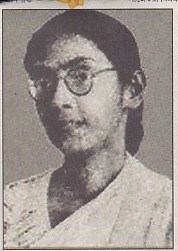Bina Das
Bina Das | |
|---|---|
বীণা দাস | |
 | |
| Born | 24 August 1911 Krishnanagar, Bengal Province, British-occupied India |
| Died | 26 December 1986 |
| Organization(s) | Jugantar and Indian National Congress |
| Movement | Indian Independence movement |
| Father | Beni Madhab Das |
| Awards | Padma Shri Award |
Bina Das (1911–1986) was an Indian revolutionary and nationalist from West Bengal.
Life
Family
She was the daughter of a well-known Brahmo teacher, Beni Madhab Das and a social worker, Sarala Devi. Her elder sister Kalyani Das (Bhattacharyee) was also a freedom fighter.
School and College
She was a student of St. John's Diocesan Girls' Higher Secondary School
Participation in India's freedom struggle
Bina Das was a member of Chhatri Sangha, a semi-revolutionary organisation for women in Kolkata. On 6 February 1932, she attempted to assassinate the Bengal Governor Stanley Jackson, in the Convocation Hall of the University of Calcutta. The revolver was supplied by another freedom fighter Kamala Das Gupta.[1] She fired five shots but failed[2] and was sentenced to nine years of rigorous imprisonment.[3][4]
After her early release in 1939, Das joined the Congress party. In 1942, she participated in the Quit India movement and was imprisoned again from 1942–45. From 1946–47, she was a member of the Bengal Provincial Legislative Assembly and, from 1947–51, of the West Bengal Legislative Assembly. In 1947, she married Jatish Chandra Bhaumik, an Indian independence movement activist of the Jugantar group.[5]
Her sister edited Kalyani Bhattacharjee a book called Bengal Speaks (published in 1944), and dedicated it to her.[6]
She was a friend of Suhasini Ganguly, a freedom fighter.[7]
Award
She won the Padma Shri award in 1960 for her "Social Work".[8]
Certificate of Merit
In 2012, she (and Pritilata Waddedar) were conferred their certificates of merit posthumously.[9]
Death
After the death of her husband, she led a lonely life in Rishikesh and died in anonymity. Her dead body was recovered from the roadside in 26 December 1986 in a partially decomposed state. It was found by the passing crowd. The police was informed and it took them a month to determine her identity.[5]
Works
Bina Das wrote two autobiographical works in Bengali: Shrinkhal Jhankar and Pitridhan.[5]
References
- ^ Kumar, Radha (1997). The History of Doing: An Illustrated Account of Movements for Women's Rights and Feminism in India 1800-1990. Zubaan. ISBN 9788185107769.
- ^ Five shots fired at governor Glasgow Herald, 8 February 1932, p. 11
- ^ Girl, would-be assassin, gets nine years in India at Reading Eagle, 15 February 1932
- ^ "Bina Das, Forgotten female freedom fighters". dnaindia.com. 15 April 2017. Retrieved 30 June 2017.
- ^ a b c Sengupta, Subodh Chandra and Anjali Basu (ed.) (1988) Sansad Bangali Charitabhidhan (in Bengali), Kolkata: Sahitya Sansad, p.663
- ^ Sengupta, Subodh; Basu, Anjali (2016). Sansad Bangali Charitavidhan (Bengali). Vol. 1. Kolkata: Sahitya Sansad. ISBN 978-81-7955-135-6.
- ^ Chatterjee, India. "The Bengali Bhadramahila —Forms of Organisation in the Early Twentieth Century" (PDF). Manushi: 33–34.
- ^ "Padma Awards Directory (1954–2014)" (PDF). Ministry of Home Affairs (India). 21 May 2014. pp. 11–37. Archived from the original (PDF) on 15 November 2016. Retrieved 22 March 2016.
- ^ "After 80 yrs, posthumous degrees for revolutionaries - Times of India". The Times of India. Retrieved 21 December 2017.
External links
- Biography by Bharatiya Vidya Bhavan
- Ahmed, Lilyma (2012). "Women". In Islam, Sirajul; Jamal, Ahmed A. (eds.). Banglapedia: National Encyclopedia of Bangladesh (Second ed.). Asiatic Society of Bangladesh.
- Bengalee women
- Statement before the Special Tribunal of Calcutta High Court by Bina Das
- St. John's Diocesan Girls' Higher Secondary School Official Website
- 1911 births
- 1986 deaths
- Revolutionary movement for Indian independence
- Brahmos
- Indian National Congress politicians from West Bengal
- Bethune College alumni
- University of Calcutta alumni
- Relief workers in Noakhali
- Bengali Hindus
- Recipients of the Padma Shri in social work
- Indian women social workers
- 20th-century Indian women politicians
- 20th-century Indian politicians
- 20th-century Indian educators
- People from Krishnagar
- Women in West Bengal politics
- Social workers from West Bengal
